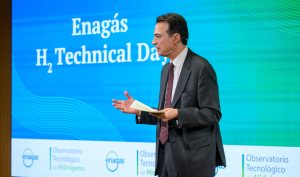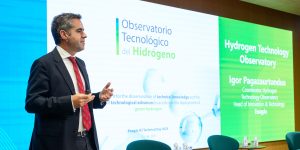Enagás held the second edition of its H2 Technical Day in Madrid on 11 June, with a single purpose: to showcase technological advances in hydrogen and highlight its technological maturity.
The sector is going through a period of remarkable dynamism, as reflected in recent news that generated a great deal of interest: Enagás has signed the European Grant Agreement, through which it will receive 32.5 million euros through the Connecting Europe Facility (CEF), earmarked to promote studies and engineering for this network
Arturo Gonzalo, CEO of Enagás, underlined the importance of EU funding for the deployment of a hydrogen economy: “We are making progress on the Spanish hydrogen backbone as planned,” he said, going on to emphasise that this backing will mark the start of a “new technological cycle”. In what he called “a pivotal moment”, Gonzalo stressed that the technology is already scaling up and will soon scale up even faster.

“We are developing the hydrogen backbone in Spain,” Gonzalo emphasised. “We have started the public consultation process as a Project of Common Interest (PCI), on a scale never seen before in our country. We’re talking about 2,600 kilometres of linear infrastructure, with 550 municipalities involved. We’re holding meetings with residents and local agents to explain the characteristics of this infrastructure and the value it will generate in local communities,” he explained.
Arturo Gonzalo: “We are developing the hydrogen backbone in Spain”
Spain, Gonzalo pointed out, leads the second auction of the European Hydrogen Bank, both in terms of the number of projects presented and awarded, offering a competitive average production price. Innovation, he added, is the differentiating factor driving this European transformation. In fact, the European continent accounts for 28% of the world’s hydrogen patents, compared with 24% in Japan and 20% in the United States. Spain plays a very important role in this respect, as it is among the ten countries with the highest number of patents in this field.
The first technical presentation of the event was given by Emilio Nieto, director of the National Hydrogen Centre (CNH2). His presentation gave a broad overview of the development of hydrogen in Spain, based on a study conducted together with the Spanish Hydrogen Association (AeH2). According to him, “we have more than 360 projects in Spain”.
The analysis showed a dynamic and distributed ecosystem. “There is no [autonomous] community without a proposal,” Nieto stressed, underlining the regionally inclusive nature of hydrogen development. Today, nine projects are already in operation, and it is expected that “by 2030 or 2031 we will be adding 365 evolving projects” throughout the value chain, with the aim of reaching 12 GW of installed electrolysers by 2030.
In terms of investment, the sector has already raised more than 35 billion euros, with financing mechanisms such as “two thirds in public funding and one third in private investment”. In addition, “more than 60 projects will reach the final investment decision (FID) this year”. On the technologies used, there is a balance between alkaline and polymer membrane electrolysers, and some projects are already exploring emerging technologies such as solid oxide (high temperature), according to Nieto.
Digitalisation is an urgent necessity to meet the unprecedented challenge of completely transforming our economic and energy model
On the other hand, digitalisation is an urgent necessity to meet the unprecedented challenge of completely transforming our economic and energy model in just a decade. This was one of the central points of the first round table of the Enagás H2 Technical Day, moderated by Pedro del Castillo, Enagás’ Director of Digitalisation and AI, and which brought together three leading profiles: Roger Guimerà, Research Professor at the Catalan Institution for Research and Advanced Studies (ICREA) of the Rovira i Virgili University; Natalia Matute, Director of Building Information Modelling (BIM) at BIP Consulting Spain and Nina Bergmann, Manager of Sustainability Strategy and Office of the CEO at Siemens Iberia.
Roger Guimerà explained: “We’re talking about digitalisation because we have a major challenge, which is to transform our economy and the way we generate energy.”
Natalia Matute, from BIP Consulting Spain, spoke about the evolution of BIM towards live systems, connected in real time. As she said, “our goal has never been just to have a static BIM model but to achieve a digital twin also connected to operation and maintenance”. She described how dynamic data, such as flow in a pipe, pressure, temperature, energy consumption, or the state of a valve, is integrated with the static model, resulting in a system that enables real-time operational decisions.
Nina Bergmann, from Siemens Iberia, advocated the vision of natively digital assets, connecting the physical and digital world to generate real value.
With Pedro Rubio, Director of Technical Services and Technology at Enagás, as moderator, Enagás brought together the industrial sector represented by the OEMs in the second round table: Vauhini Telikapalli, Global Hydrogen Business Development Manager at Burckhardt Compression; Marco Baldini, Hydrogen Solutions Architect at Baker Hughes; Holger Brauer, R&D Manager at Mannesmann Line Pipe; Olga Kotkowska, Business Development Team Leader at Endress+Hauser SICK; and Federico Ricotti, Valve Engineering Manager at SLB.
It was evident that the European energy transition is at a turning point, and original equipment manufacturers (OEMs) are positioned as key players, not only as technology suppliers, but also as strategic partners in the development of an efficient, robust and interconnected hydrogen network.
Europe’s energy transition is at a turning point, and original equipment manufacturers (OEMs) are positioning themselves as key players
The importance of flexibility to adapt systems to repurposed infrastructures and the importance of long-term purchasing agreements to reduce risks and stimulate the market were highlighted. Because the goal is to make hydrogen competitive. They also highlighted the opportunity to move towards harmonised hydrogen regulation, which would reduce delays and costs. In this regard, they underlined the importance of fostering collaboration throughout the value chain to accelerate the development of the sector”.
The analysis of the midstream was the technical core of the third round table, moderated by Claudio Rodríguez, Director General of Infrastructures at Enagás and President of the Hydrogen Gas Assets Readiness (H2Gar) initiative.
Representatives from several H2Gar working groups participated: Iván Montero, Equipment and Materials Coordinator of Enagás; the expert Francis Bainier, at NaTran; the Plant Manager of Machines, Control Systems and Complex Processes at Snam, Marco Tarenzi; the Innovation and Technological Development Coordinator of Enagás, José Alfredo Lana; the Senior Engineer at National Gas, Lisa Witty; and the Environmental Engineer at Snam, Donatella Barbieri.
The consensus was clear: structural integrity is a major challenge.
The technical proposals shared were: in-depth material characterisation, development of risk analysis tools, operational integrity audits and specific design guidelines for large metering networks. The importance of automated continuous detection systems (in-line sensors, pressure and temperature analytics), which allows a rapid response to anomalies, was also mentioned.
Over the past five years, more than 700 hydrogen-related projects have been funded in Europe, mainly as part of the Horizon Europe programme
With the Director General for Engineering, Technology and Digitalisation, Susana de Pablo, leading the discussion, this round table brought together Marina Holgado, Coordinator of the Technical Secretariat of the Spanish Hydrogen Technology Platform (PteH2); Robert Judd, Secretary General of the European Gas Research Group (GERG); and Javier Navarro, member of the Hydrogen Europe Board of Directors.
It was highlighted that more than 700 hydrogen-related projects have been funded in Europe in the last five years, mainly as part of the Horizon Europe programme, with a public budget of more than 3.3 billion euros.
Javier Navarro of Hydrogen Europe emphasised the need for systemic improvement throughout the hydrogen value chain, from production to end use. He stressed that demonstration projects are essential to validate technical and economic feasibility, as well as to develop safety standards, clear regulations and innovative business models to facilitate the integration of hydrogen into industrial sectors and global markets.
Marina Holgado, from PteH2, gave a detailed overview of the Spanish scene. She explained that Spain has a strong network of researchers currently tackling key challenges such as reducing the use of critical materials in electrolysers, the compatibility of materials for storage and transport, and the development of industrial applications and mobility, all with the aim of improving efficiency, safety and sustainability.
Robert Judd of GERG noted that the current hydrogen revolution is the biggest transformation the gas industry has ever seen, with an unprecedented increase in projects and intense collaboration to accelerate technology deployment, reduce costs and ensure safety in this emerging new industry.
Igor Pagazaurtundua, Innovation and Technological Development Manager at Enagás, also spoke about the progress of the Hydrogen Technology Observatory, an initiative launched by Enagás in 2024, which has more than 60 partners in various fields (universities, companies, technology centres).

Among the milestones, the Observatory coordinator announced the imminent publication of the first collaborative report focusing on the role of hydrogen in maritime decarbonisation.
The Hydrogen Technology Observatory is an initiative launched by Enagás in 2024 and has been joined by more than 60 partners from various fields
The conclusion – a speech by Natalia Latorre, Director General of Energy Transition at Enagás – reaffirmed the need for public-private partnership, constant innovation and sustainable leadership.
Latorre called for three key commitments to boost the hydrogen ecosystem: disseminating knowledge and progress to raise awareness; fostering collaboration, as the sector’s goals cannot be achieved individually; and building hydrogen value chains by leveraging existing experience, but incorporating innovation and new technologies to adapt to the new energy system.
In short, the Enagás H2 Technical Day demonstrated a firm commitment: to coordinate industrial, technological and regulatory efforts to consolidate a connected, solid, Europe-wide hydrogen economy, in which the Spanish hydrogen backbone will play a strategic role.